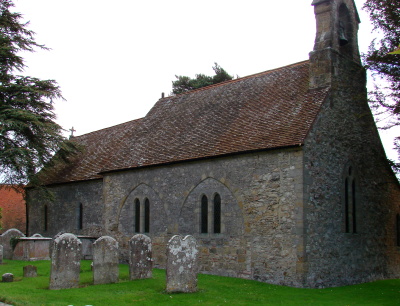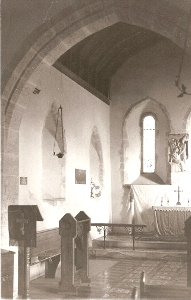Barlavington – St Mary
A small church under the Downs of c1200, it had provision for two aisles, though probably only the south one was built. It was reconstructed in 1874. The work, the authorship of which is in doubt, was thorough but sensitive.
The area west of Bignor under the Downs has changed little since the Middle Ages, with sunken roads linking the scattered villages. Barlavington church stands down a turning by a farm, which is its only close neighbour.
Though close to the Downs, it is built of rough sandstone. Nothing appears older than c1200, the presumed date of nave and chancel, though Adelaide Tracy (1849) (II p21) shows a round-headed chancel arch with plain abaci. According to her note it was then cemented. This could be C12 in origin and thus rather earlier than the rest of the structure appears to be. However, it is consistent with the date of first building of other churches in the area. Until the C19, it had two flanking, pointed niches, of which the south one contained a squint. The presence of a squint suggests that this arrangement was mediaeval and that the cement was the result of later repairs.
The date of the chancel is confirmed by two round-headed east lancets with rere-arches which lack scoinsons, though the pointed side-lancets do have them. The difference is hard to expain unless the side-ones have been altered, though their appearance is old. Between the east ones is a shallow square-topped recess as at Greatham. Unusually, the piscina is under the south west lancet, so its sill is higher (see below). The south arcade as built was of similar date to the chancel, with a single round pier and square abacus and chamfered arches. From Debary’s (1 p53) description, it was little changed when it was unblocked in 1874 and is probably at least partly original. The south aisle was probably still standing in 1530, the date of a bequest to the altar of Our Lady (2 p1), for such altars generally stood in the south aisle. It is doubtful if the north aisle was ever built, for though there is the outline of an arcade, it has no pier or responds – the present pairs of lancets in the blocking are C19. Drawings, such as Quartermain’s ((W) p299) and the Sharpe Collection (1804), show obviously post-Reformation pointed, mullioned windows in this position and a large square timbered bell-turret like others in the area.
A comparison of the church before the restoration of 1873-74 with the present shows the extent of the work. The cost of this is said to have been £530 (PP125), but this must be an underestimate. The report in The Builder of the re-opening (32 p58) gives no architect. Basil Clarke in his papers attributed Barlavington to ‘GES’ (i e G E Street), but gave no source; some later authorities have followed this attribution (eg Beevers, Marks and Roles p78). It probably derives from A E Street’s memoir of his father, which lists an undated restoration of ‘Woollavington, Sussex’, an alternative name for East Lavington, which was beyond doubt restored by J P Harrison. The attribution of Barlavington to Street would be plausible, for he worked nearby at Graffham and Bignor and was associated with Samuel Wilberforce (‘Soapy Sam’), Bishop of Oxford, whose family estate covered East Lavington and Graffham, but no supporting evidence has emerged and though the estate as a whole was often called Woollavington (a later C19 owner took the title of Lord Woollavington), it never included Barlavington. Street rebuilt Graffham church as a memorial to Wilberforce and it is most likely that A E Street had this in mind. This seems surprising as he himself worked on Graffham after his father’s death, but he was sometimes inaccurate despite access to his father’s records. Confusion with Woolavington (sic) (Somerset) can be ruled out.
Whoever the architect was, it is hard to believe that much of his work is not mediaeval, largely because he used local stone, hand-hewn like mediaeval work; that is an argument in favour of Street, since this is also a feature of his work at Graffham, but it is nevertheless likely that there would be some other record if he were responsible. The south aisle was reconstructed in an appropriate early C13 lancet style, the arcade was repaired and the chancel arch was replaced, though the side-openings were destroyed. A stone belfry and west window were added and the roofs were replaced, though the nave one re-uses the original corbels. The only obvious C19 note is the shiny Minton tiles (B ibid).
Probably because of its remoteness, the church was later neglected. In 1954 the west wall was said to be ‘in a tragic state’ (3 p65), but its condition now appears satisfactory.
Fittings
Carving: (Recess at east end) Annunciation in oak by A Ayres, 1967 (2 p2).
Font: Plain octagonal C19.
Piscina: (Under south east lancet) Small early C13 triangular-headed.
Sources
1. T Debary: The Lavingtons, SAC 29 (1879) pp46-71
2. F W Steer: Guide to the Church of St Mary, Barlavington (Sussex Churches No 43), 1970
3. Sussex Archaeological Society Meeting – Report, SNQ 14 (Nov 1954) p65



